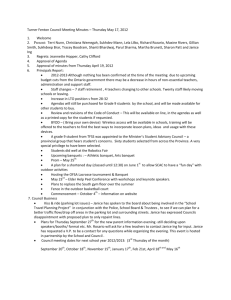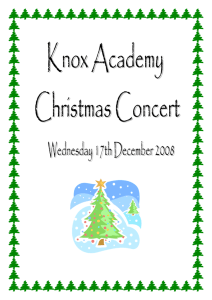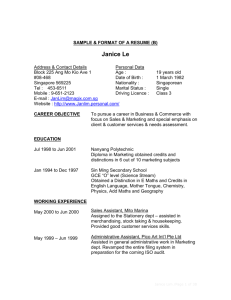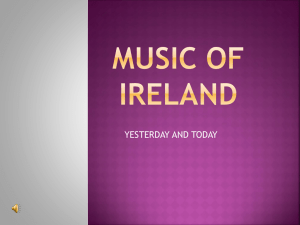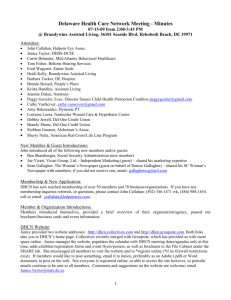Celtic Dreams Booklet
advertisement
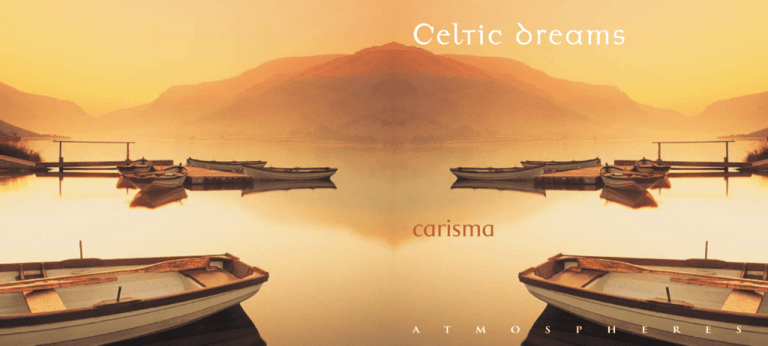
carisma A T M O S P H E R E S About this album… In this album, carisma presents a new look at the rich culture of Celtic music from Ireland, Scotland and Wales. Since we started making music together in 2005, we have always included Celtic music in our repertoire and we enjoy presenting it in the ‘carisma’ style. Celtic Dreams includes our personal favourite Celtic songs as well as music our concertgoers have enjoyed. The pieces range from traditional tunes dating back to medieval times right up to the contemporary Celtic music which is alive and thriving today. It has been a rewarding and enjoyable experience for us to explore the different moods of the pieces – from haunting, mystical melodies and gentle lullabies to the more lively and exuberant tunes. We are indebted to our special guest artists David Jones (drums and percussion) and Michael Knopf (guitar) for coming to play with us, and to Jill Atkinson, our co-producer, and Geoff McGahan, our engineer, for guiding and encouraging us through the whole journey of recording this album. Happy listening! carisma is Anna Stoddart flute, alto flute and tin whistle Janice Preece harp Louise King cello 2 3 1 Brian Boru’s March 2’55 4 Tra Bo Dau 2’55 Trad. Irish arr. Peter Michael von der Nahmer Trad. Welsh arr. Janice Preece, percussion part by David Jones Brian Boru was one of Ireland’s greatest kings. He reigned for 39 years, promoting learning and This is a traditional Welsh love song and it comes from the collection Welsh Melodies, edited by the arts, and it was a time of unsurpassed glory, prosperity and happiness. He died when he J. Lloyd Williams and Arthur Somervell. Williams learnt the song from his wife and sister who was 89 years old, leading the Irish troops during the Battle of Clontarf, which occurred in 1014: came from Criccieth in North Wales, not far from where Janice, our harpist, was born. the Irish army repelled the Vikings but Boru was killed. Brian Boru’s March is a military tune Mae’r hon a gâr fy nghalon i She whom my heart loves Ymhell oddi yma’n byw; is living far away; A hiraeth am ei gweled hi my face is pale Sir John Stevenson arr. Janice Preece A’m gwnaeth yn llwyd fy lliw. with longing for her. The poem The Last Rose of Summer was written by Irish poet Thomas Moore in 1805 while at Cyfoeth nid yw ond oferedd, Wealth is nothing but vanity, Jenkinstown Park in County Kilkenny, Ireland. The music was composed by Sir John Stevenson Glendid nid yw yn parhau; beauty will not last, and it was published in a collection of Moore’s work called Irish Melodies (1807–1834). Ond cariad pur sydd fel y dur but faithful love endures like steel Yn para tra bo dau. as long as both remain. written in commemoration of the battle. 2 The Last Rose of Summer 3’37 The song appears in Friedrich von Flotow’s opera Martha which premiered in 1847 in Vienna. It is the favourite air of the character Lady Harriet and it helped to make the opera a popular success. 3 Skye Boat Song 3’40 Trad. Scottish arr. Janice Preece The Skye Boat Song was first published in Songs of the North by Boulton and MacLeod in 1884. The words are by Sir Harold Boulton. The first half of the tune is said to be an old sea shanty and the other half of the tune is traditionally attributed to Miss Annie MacLeod. The song recalls the escape of Bonnie Prince Charlie after his defeat at Culloden in 1746, rowing (disguised as a serving maid) from Uist to the Isle of Skye in a small boat, with the aid of 5 Lift the Wings 2’39 Bill Whelan arr. Janice Preece Lift the Wings is from the theatrical show Riverdance which was first performed during the interval of the Eurovision Song Contest in 1994. The song refers to the many Irish men and women who, starting in the mid-19th century, were driven out of Ireland by hunger, famine and ambition, crossing the Atlantic to America. While those souls who were forced to emigrate were faced with the heartbreak of separation from their families, their human spirit was often lifted by a defiant hope at the prospect of a new and better life. Flora McDonald. 4 5 6 ’Na mo chlàrsaich cha robh ceòl Thou art the music of my heart, Trad. Irish arr. The Corrs adapted by Janice Preece; drums and percussion part by David Jones, ’Na mo mheoirean cha robh àgh, Harp of joy, o cruit mo chridh [harp of my heart], guitar part by Michael Knopf Rinn do phògsa mo leon, Moon of guidance by night, Fhuair mi Eolas an dàin. Strength and light thou art to me. Bheir mi òro bhan o… I’ve gone away, O dear one… Erin Shore 4’30 Erin Shore, a traditional Irish melody, was recorded by The Corrs, a Celtic folk rock group from Dundalk, County Louth, Ireland, on their debut album Forgiven, Not Forgotten, which was released Second verse by Kenneth MacLeod by Atlantic Records in 1995. The album reached platinum status in the UK and Australia and quadruple platinum in Ireland. Our version is a tribute to The Corrs’ beautiful interpretation of this 8 Celtic song. 7 O’Carolan’s Concerto 3’34 Turlough O’Carolan arr. Dan Reiter and Emily Cox An Eriskay Love Lilt 2’08 Turlough O’Carolan (1670–1738) is the best known of the ancient Irish harpers. He was born near Trad. Scottish arr. Janice Preece Nobber, County Meath. Although he was blind, he travelled around Ireland composing music for Eriskay is a small island of only three square miles off the coast of South Uist in the Outer his patrons and playing his harp. O’Carolan’s Concerto, also known as Mrs Power, is dedicated to Hebrides, Scotland. In 1745, a small frigate landed Bonnie Prince Charlie on Eriskay to start the the wife of David Power who lived at Coorheen. This arrangement is for cello and harp. ‘Forty-Five Jacobite Rising’. 6 English adaptation by Marjory Kennedy-Fraser 9 Bheir mi òro bhan o I’ve gone away, O dear one Bheir mi òro bhan i I’ve gone away, O dear one Bheir mi òru o ho I’ve gone away, O dear one ’S mi tha bronach ’s tu ’m dhith. Sad I am without thee. ’S iomadh oidhche fliuch is fuar When I’m lonely, dear white heart, Ghabh mi cuairt is mi leam fhin, Black the night and wild the sea, Gus an d’rainig mi’n t-àit By love’s light my foot finds Far ’n robh gradh geal mo chridh. The old pathway to thee. Bheir mi òro bhan o… I’ve gone away, O dear one… Suo Gân 2’57 Trad. Welsh arr. D. Foyster adapted by Janice Preece Suo Gân is a traditional Welsh lullaby. This hauntingly beautiful song featured prominently in the film Empire of the Sun. It has also been recorded by renowned Welsh singers Aled Jones and Charlotte Church. The heartfelt lyrics of this lullaby capture perfectly a mother’s loving and comforting touch towards her baby. Huna blentyn yn fy mynwes Sleep, my child, upon my bosom, Clyd a chynnes ydyw hon; it is snug and warm; Breichiau mam sy’n dynn amdanat, your mother’s arms wrapped tightly around you, Cariad mam sy dan fy mron; ’tis a mother’s love lies in my breast. 7 Ni cha’ dim amharu’th gyntun, Nothing shall disturb your slumber, Ni wna undyn â thi gam; nobody will do you harm: Huna’n dawel, annwyl blentyn, sleep in peace, dear child, Huna’n fwyn ar fron dy fam. gently sleep on your mother’s breast. 12 Be Thou My Vision This ethereal and haunting love song was first published in 1904 in Songs of Uladh by Herbert Hughes and Joseph Campbell. Hughes collected the song in 1903. He first heard it on a fiddle and traced it back to a sapper of the Royal Engineers working in Donegal in 1870 with the Ordnance Survey of Ireland. 5’26 The Lagan is the river which flows through Belfast, but it is believed that the Lagan in this song Trad. Irish arr. John Rutter, adapted by Janice Preece refers to a stream that empties into Lough Swilly in County Donegal, not far from Letterkenny Be Thou My Vision has become a quintessential Irish hymn in English-speaking churches and is where Herbert Hughes collected the song. often sung around St Patrick’s Day. The tune is from an old Irish folk song called Slane, after Slane Hill where in 433 AD St Patrick defied the pagan High King Lóegaire of Tara by lighting 13 candles on Easter Eve. The beautiful arrangement for choir and harp by the English composer Planxty Burke Morning Has Broken 1’35 Trad. Scottish arr. John Rutter, adapted by Janice Preece John Rutter has been adapted by Janice for alto flute, harp and cello. 11 3’29 Trad. Irish arr. Jonathan Price English translation: Meinir Pritchard 10 My Lagan Love Morning Has Broken is a favourite and well-known Christian hymn. The tune is based on a Scottish Gaelic traditional melody called Bunessan and the lyrics were written by Eleanor Farjeon 3’03 Turlough O’Carolan arr. Janice Preece; percussion part by David Jones, guitar part in 1922. Cat Stevens popularised this song when he included it on his 1971 album Teaser and by Michael Knopf the Firecat. A planxty is a song of praise; Planxty Burke was written in honour of Isabella and Thomas Burke, members of a ‘respectable family’ who lived near Castlebar. Thomas is listed as representing the Borough of Castlebar in King James’ Parliament of 1689. 14 Water Shore Sound 3’28 Fran Gray arr. Janice Preece and Michael Knopf This peaceful melody was given to Janice by Scottish harpist Margaret Knight when she visited Australia in 2008. It is a perfect example of contemporary Celtic music. The composer, Fran Gray, lives in Burray, Scotland, and Water Sound is the beautiful stretch of water in Scapa Flow which is visible from her house. 8 9 15 She Moved through the Fair 4’51 Trad. Irish arr. Jonathan Price She Moved through the Fair was first collected in Donegal by Padraic Colum and Herbert Hughes and was published in Irish Country Songs in 1909. Some claim the melody dates back to medieval times. The lyrics for the song were mostly written by Padraic Colum. 16 The Salley Gardens 2’46 Trad. Irish arr. Benjamin Britten, adapted by Louise King and Janice Preece The Salley Gardens evolved from a poem of the same name by William Butler Yeats, published in his collection Crossways in 1889. Herbert Hughes, an avid collector of Irish folk melodies, set it to music. A salley is a willow tree (the Gaelic for ‘willow’ is saileach) and it was once common in Ireland to have gardens of willow. Willow rods were used for basket-making and for thatch roofing of cottages. Our version of this well-loved Irish tune is based on Benjamin Britten’s arrangement; as well as some interesting colours in the harp and cello, it features Anna on the tin whistle. 17 Runaway 4’22 The Corrs arr. Janice Preece; drums and percussion part by David Jones Runaway was first released in September 1995 as The Corrs’ debut single; re-released in 1999, it reached No. 2 in the UK singles chart. 10 11 About carisma… carisma was founded by Anna Stoddart (flute) and Janice Preece (harp), who have a history of superb music-making together. They have teamed up with Louise King (cello) to create this enigmatic trio which makes eclectic and alluring music. carisma is more than a name; it is the quintessence of their musical philosophy. They make music to move, inspire, uplift and compel their audience – to delight them and take them to new places of the heart. carisma achieves this through its discerning musical choices and through the sheer quality of each member’s artistry. Hearing the music of carisma is like receiving a sensory awakening: an inspirational gift for the soul. www.carisma.com.au Anna Stoddart Anna Stoddart is a truly charismatic individual, both musically and personally, who engages those she meets. She approaches her music with a sensitivity and flexibility that come from that dynamic combination of passion, skill and experience. Her dynamic musical style has developed through a performance career which has encompassed a wide variety of musical styles, from classical to jazz to soul. Anna graduated in 1974 with a Bachelor of Arts (Music) degree from the Queensland Conservatorium, with distinction in Flute and Teaching. She became an instrumental music teacher with Education Queensland and taught in several Queensland schools. Highlights of Anna’s career include lecturing in Flute at the University of Southern Queensland, performing as a member of both the Queensland Symphony and Queensland Philharmonic Orchestras, and directing and performing with various renowned local ensembles. 12 13 Janice Preece Janice Preece was born in Wales, the land of song and music. This homeland is the place she found her love of music – it was in the very air she breathed. After graduating from the University of North Wales with an honours degree in Music, she completed a postgraduate course in Harp Performance at the Welsh College of Music and Drama, Cardiff. Janice went on to win the Harp Competition at the Royal National Eisteddfod of Wales. In recognition of her musical gifts, Janice was admitted as a bard in her home country. Her Bardic name is ‘Telynores Dwyfor’ which translates as ‘The Harpist of Two Seas’. This name took on profound significance when she made Australia her new home while maintaining strong links with her Welsh homeland. Janice has earned an international musical reputation through her performances in various symphony orchestras in Australia and the United Kingdom, and the demand for her gifts and skills has taken her to many unique destinations both in Australia and abroad. She is currently Principal Harpist with the Queensland Pops Orchestra. Louise King Executive Producers Martin Buzacott, Robert Patterson Recording Producers Jill Atkinson, Geoff McGahan & carisma Recording Engineer and Mastering Geoff McGahan Editorial and Production Manager Katherine Kemp Publications Editor Natalie Shea Booklet Design Imagecorp Pty Ltd Cover Photo Snowdonia National Park (www.fotosearch.com) Artist Photography Antoinetta’s Photographics Annotations carisma Recorded 29-31 October 2008 at Ghostgum Studios, Cannon Hill, Brisbane. ^ recorded September 2005 in the Australian Broadcasting Corporation’s Ferry Road studios, Brisbane. ABC Classics thanks Alexandra Alewood. 2009 Australian Broadcasting Corporation. 2009 Australian Broadcasting Corporation. Distributed in Australia and New Zealand by Universal Music Group, under exclusive licence. Made in Australia. All rights of the owner of copyright reserved. Any copying, renting, lending, diffusion, public performance or broadcast of this record without the authority of the copyright owner is prohibited. Louise King migrated to Australia from England in 2003. She has an appetite for adventure and has travelled to exotic climes with her cello, performing and soaking up life as she goes. Her musicmaking is daring and vibrant and she plays with a stylish freshness and breathtaking versatility. Upon graduating with honours and winning every chamber music prize from the Royal Northern College of Music, Manchester in 1997, Louise worked with the Northern Sinfonia, New London Soloists Orchestra, Hong Kong Philharmonic Orchestra, Hallé Orchestra and the BBC Philharmonic. Louise has performed in masterclasses given by Christopher Bunting, Anner Bylsma, Ralph Kirshbaum and Steven Isserlis and studied with William Pleeth at the Britten-Pears School and with Karine Georgian at the Dartington International Summer School. She currently freelances with the Australian Chamber Orchestra, The Queensland Orchestra, Topology and Southern Cross Soloists. 14 15
